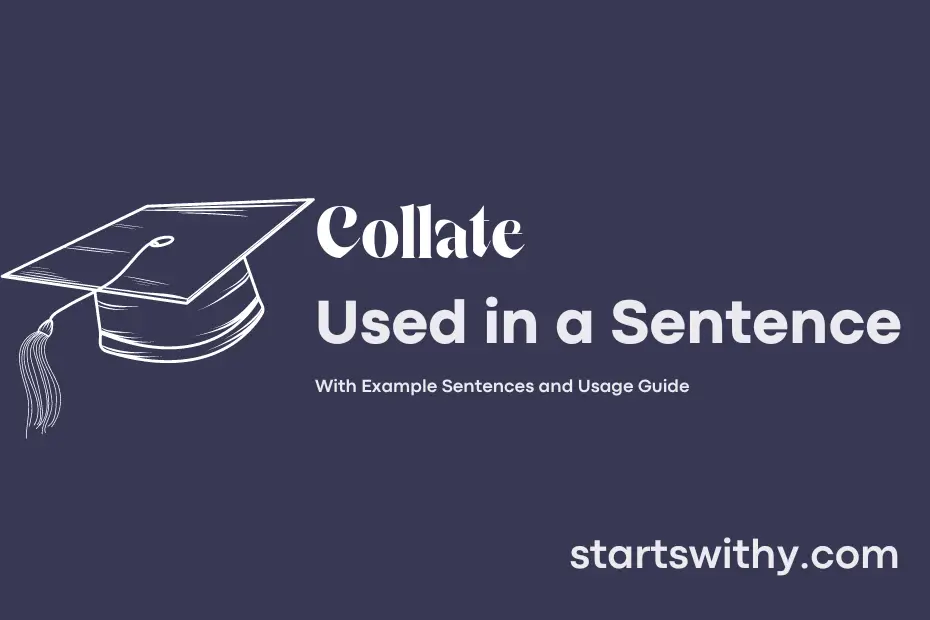Have you ever wondered how to efficiently organize and assemble various pieces of information into a coherent format? This process is known as collating. Collating involves gathering, arranging, and sorting data or documents to ensure they are in proper order or sequence.
Whether you are compiling research findings, organizing financial records, or putting together a report, proper collation is essential for clarity and comprehension. By mastering the skill of collating, you can streamline information, facilitate accessibility, and present your content in a structured and logical manner.
7 Examples Of Collate Used In a Sentence For Kids
- Collate all the red blocks together.
- Let’s collate the pictures of animals.
- We need to collate the books by size.
- Can you help me collate the stickers?
- It’s time to collate the colored pencils.
- We will collate the toys by type.
- Please collate the fruits into different groups.
14 Sentences with Collate Examples
- Students can collate all their research findings and references in one document for easier referencing.
- It is important for college students to collate all their notes from various classes to prepare for exams.
- Before starting a group project, students should collate all their ideas and present them to each other.
- To save time on group assignments, it’s helpful to collate everyone’s contributions into one cohesive project.
- When writing a thesis, it’s crucial to collate all relevant data and sources to support your argument.
- As part of their final project, students may be required to collate data from surveys or experiments.
- In order to better understand a complex topic, students should collate information from multiple sources.
- To effectively study for an upcoming exam, students should collate their notes, textbooks, and additional resources.
- When working on a literature review, it’s important to collate all the relevant studies on the topic.
- Before submitting a research paper, students should collate all their findings and analyze the data.
- College students can collate their class schedules, assignment due dates, and extracurricular activities in a planner to stay organized.
- One way to improve group presentations is to collate all members’ insights and findings into a cohesive narrative.
- To streamline their research process, students can use software tools to automatically collate and organize data.
- Faculty members can encourage students to collate their thoughts and questions before engaging in classroom discussions.
How To Use Collate in Sentences?
Collate means to collect, arrange, and assemble related items in a systematic way. To use collate in a sentence, start by identifying a group of items or information that needs to be organized. For example, “Please collate all the documents related to the project proposal.”
Next, determine the order in which the items should be arranged. You can use words like “alphabetically,” “numerically,” or “chronologically” to specify how the items should be collated. For instance, “After you collate the papers, arrange them chronologically according to their submission dates.”
When constructing a sentence with collate, make sure to include a clear instruction or request to ensure that the recipient understands what needs to be done. For example, “I need you to collate the sales reports and organize them alphabetically by region.”
Remember to be specific and provide all necessary details when using collate in a sentence. This will help avoid confusion and ensure that the items are collated correctly. Practice using collate in different contexts to become more comfortable with incorporating it into your writing and communication.
Conclusion
In summary, the process of gathering, organizing, and comparing information from various sources or datasets, known as collating, is essential for ensuring accuracy and efficiency in data analysis. By collating key details or data points, researchers, analysts, and professionals can derive meaningful insights and make informed decisions. This method facilitates the identification of patterns, trends, and discrepancies, ultimately leading to well-informed conclusions.
Through collating data, individuals can streamline the analysis process, identify correlations, and pinpoint areas for further investigation. This systematic approach helps in synthesizing diverse information into a coherent and comprehensive overview, enabling better understanding and interpretation of complex datasets. Overall, the practice of collating enhances the quality of decision-making, research outcomes, and problem-solving strategies by integrating and organizing information in a structured and logical manner.



